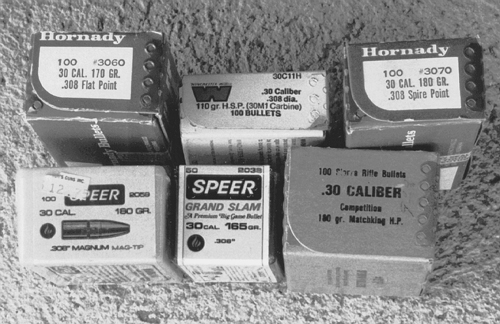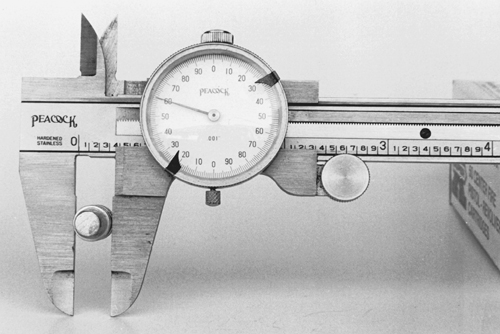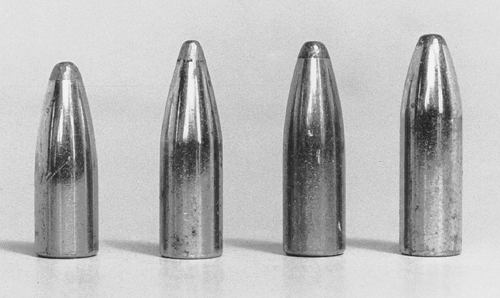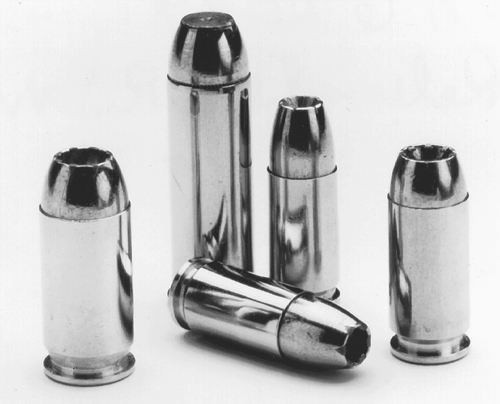
With so many projectiles available in so many shapes and sizes, how do you find the one that's best? It depends on your intended reloading and shooting application.
Most guns of today are standardized in terms of bore diameter and rifling characteristics. If you are dealing with a knowledgeable reloading supplies dealer, a simple request for “some hunting bullets for my 30-30″ will probably get you what you want. Unfortunately there are dealers who are not very knowledgeable and a few who are mainly interested in unloading what they have in stock. “Caveat emptor” is still the safest position to take.
This section refers to getting the “best” bullet. The first thing you should have in mind when you go to buy bullets is a clear idea of what “best” means for your intended use. For any gun the first consideration for any use should be accuracy. Whether it’s for target or game, an inaccurate bullet is worthless.
The quickest and easiest rule of thumb when it comes to buying bullets is to get what duplicates the factory loading. If you want ammunition for special purposes, which most handloaders eventually will, then you will have to do a little research like reading this book. Old guns and those of foreign extraction can often be confusing in regard to what their bore and groove size actually is. The best information collected over the past century indicates that the most accurate bullet is the one that fits the groove diameter of the barrel exactly. In the final analysis this is determined by slugging the bore of your gun and measuring the slug with a micrometer or vernier caliper and getting bullets that fit.
Proper diameter bullets can most easily be determined by reading the information on the box they come in or by measurement, if you are buying bullets in a plastic bag from someone you don’t know. This can be a little confusing. For instance, 22 caliber bullets for the early 22 Hornet rifles were properly .223″ diameter. The modern ones are .224″. And the 223 Remington (5.56mm) is .224″ diameter, not .223″!
Good loading manuals usually give warnings regarding groove diameters in the data they provide for foreign and early rifles if there is a considerable variation in these within a particular type of rifle. My Lyman manual indicates that groove diameters on the 303 British military rifles vary from .309″ to .317″! Put too fat a bullet in one of the tight ones along with plenty of powder and you can create a dangerous pressure situation in addition to inaccurate shooting. The 303 Enfield, if loaded properly, is a fine, accurate rifle, capable of turning in some excellent groups.

BULLET LENGTH AND RIFLING CHARACTERISTICS
Beyond the question of bullet diameter there is the matter of bullet length and the relationship of bullet length to the rifling twist in the barrel and how this affects accuracy. Bullets aren’t identified by length, but by weight when they are sold. All other things being equal, heavier bullets of a given diameter are longer.
One way to find out which bullets will work best in your gun is trial and error. Another way is to limit yourself to the recommendations in loading manuals. These are basically guidelines and performance for the caliber of your gun and may or may not be satisfactory to you. Beyond this there are some basic calculations which may save you a lot of time and expense on bullets that don’t work.
Therefore, a second thing you should know about the barrel of the gun you will be loading for, beyond its groove diameter, is the rate of the rifling twist. This can be found in loading manuals for a great many standard guns, certainly for the test guns used to prepare the data. This figure will be expressed, for example, as “Twist 1-10″.” This indicates that the rifling spiral makes one complete turn in ten inches. Different lengths of bullets require different rifling twists to shoot to their best advantage. If the match between bullet length and rifling is too far off, bullets may fail to stabilize and tumble in flight on the one hand or be so over stabilized they will actually break apart in flight on the other.
If there is any doubt in your mind about the twist rate of your gun, determining this is simplicity itself, at least with a rifle length barrel. With handguns, you will have to interpolate as best you can. Stand the rifle against a plain vertical surface such as a wall or door. Place a good tight patch on your cleaning rod — one that does not have a ball bearing in the handle. Once the patch is started, mark the handle and beside it make a mark on the vertical surface. Push the rod down the barrel, allowing the handle to turn freely. Make a second mark at the point where the handle has made one complete rotation. Measure the distance between the top and bottom marks and you know the twist rate to a very close degree, although there will always be a slight amount of slippage.
As a rule of thumb, longer bullets of a given caliber require a faster twist to stabilize them to the point where they shoot accurately than shorter bullets. This is true without regard to weight or velocity. The familiar 22 Long Rifle shoots best in a 1-16″ twist barrel. This holds true for 40 grain target loadings as well as 30 grain hyper-velocity hollow point hunting bullets.
These are always made to be close to the 40 grain LR bullet’s length. The stubby, 30 grain 22 Short does best in a 1-20″ twist barrel. It will stabilize in a 1-16″ barrel, but accuracy is not good. Rifles marked “22 Short, Long, or Long Rifle” are actually bored for the Long Rifle or occasionally with a compromise twist of 1-v17″, which may slightly improve the accuracy of the Short, without adversely affecting the accuracy of the Long Rifle.
Once you know the twist of your gun you can calculate which bullets will likely perform best and save money by not buying those that won’t.

THE GREENHILL FORMULA
There are some elaborate computer programs to calculate bullet length to rifling twist, but there is a very simple method that works with a pocket calculator or even paper and pencil — The Greenhill Formula. The Greenhill formula for determining twist rates was the work of Sir Alfred George Greenhill, a mathematics professor at Cambridge University who later served as an instructor at the Woolrich Military Academy from 1876 to 1906. Greenhill discovered that the optimum twist rate for a bullet is determined by dividing 150 by the length of the bullet in calibers (100ths of an inch).
The number 150 is a good choice since it allows a useful margin in the calculations. Most twist rates that are close to the formulated ideal will usually work well. The beauty of this formula is that it works very well for lead or jacketed bullets. Weight does not appear to be a critical factor. Shape and design do not seem to have that much effect either up to velocities of 2200 fps and to a degree, above this. To compensate for increased rotational speed at velocities over 3000 fps some authorities recommend a slightly reduced twist rate. Although velocity does not appear to be considered within this formula, it is included in the rotation segment in a concealed form.
Assume a 1-12″ barrel firing a bullet at 1000 fps. This equals 1000 rotations per second. At 2000 fps the rotations per second double. Higher velocity yields a faster spin and is thus considered in the calculations, although it is not specifically mentioned. The most recent interpretations of Greenhill opt for a slightly faster twist with the higher velocity cartridges in the belief that erring on the side of over-stabilization is better than under-stabilization that may result in a tumbling bullet.
The popular 223 Remington is a good candidate for study. Rifles for this cartridge are currently available with the following twist rates — 1-7″, 1-8.5″, 1-9″, 1-10″, 1-12″ and 1-14″. To apply the Greenhill Formula using the original 55 grain bullet yields the following, for one brand of full metal jacket (FMJ) military type bullet measuring .647″ in length. The bullet diameter is .224″, which divided into the length of .647″ gives 2.89 calibers long. Dividing 2.89 into 150 yields a figure of 51.90 or an ideal twist rate of one turn in 51.90 calibers. Multiply 51.90 by the bullet diameter (.224″) equals one turn in 11.63″ for this particular bullet.
The original twist for the 223 caliber M-16 rifle is 1-12″. In its wisdom (?) the Army decided a heavier (longer) bullet was necessary and the M-16A1 is bored with a 1-10″ twist. The new military bullet will not stabilize in the 1-12″ barrels. Bullets as heavy as 70 grains are available for the .223 Remington. For a 70 grain bullet measuring .785″ in length, .785 ÷ .224 = 3.50. 150 ÷ 3.50 = 42.86 or one turn in 42.86 calibers. 42.86 X .224 (i.e., the bullet caliber) = 9.60.
Thus a twist of 1-9″ or 1-10″ is required to shoot this bullet accurately, while a 1-12″ will not stabilize it and as for a 1-14″, forget it. There are other factors involved, such as the amount of bearing surface on the bullet, velocity and barrel length. In some cases bullets that are not well matched to twist rate can be made to function. For example, a short, 40 or 45 grain bullet, in a 223 with a fast twist of 1-9″ or 1-10″, will perform, if the powder charge is cut back. By decreasing the velocity, you can keep the bullet from tearing itself apart. This might be called a limited success, since in the manner of the .22 Short in the 22 Long Rifle barrel, accuracy will likely suffer.
Applying the Greenhill formula can save time and money not spent on ammunition that won’t shoot well. It can serve as a useful guide when it comes to buying a gun or having one custom barreled if you know in advance what kind of shooting you will be doing and thus what kind of bullets you will use.

RIFLE BULLETS
Military surplus and military overrun bullets may be a terrific bargain if all you want is some cheap practice ammunition. Military bullets suitable for practice are of the full metal jacketed variety. They feature a solid lead alloy core with a copper, bronze or soft steel jacket and are referred to as “ball” ammunition. These bullets are made to military specifications and will produce reasonably good accuracy for preliminary sighting in and practice. The full metal jacket prevents nose expansion and is not good for hunting.
Occasionally shooters have tried to make hunting ammunition out of FMJ bullets by filing the points off of the spitzer (pointed) military bullets, exposing the lead cores. This is a dangerous practice since the bullet already has the lead core exposed at the base. Opening the point often results in the core being blown right through the jacket leaving the jacket stuck in the barrel. When the next shot hits the jacket, the barrel is bulged and ruined. Don’t try to modify FMJ bullets! Because of bullet-to-bullet weight variation, military ammunition will never produce fine accuracy.
In a worst-case scenario, such a “bargain” could turn out to be tracer, incendiary, explosive or armor piercing bullets. Most military ammunition is identified by the color of the lacquer on the tip and in the case of the tracer, by exposed burning material at the base of the bullet. There are various books on military ammunition that will tell you how to interpret these colored-lacquer codes on a country-by-country basis.
Surplus armor piercing ammunition has been used for years as cheap practice fodder, mainly in military rifles. Philip Sharpe in his book The Complete Guide to Handloading responded to the question of whether this did any harm to rifle barrels by conducting an experiment wherein he took a “gilt-edged” match rifle barrel, targeted it with match target ammunition, then fired a few rounds of armor piercing then targeted it again with the same match ammunition, carefully cleaning between groups.
His finding was that after the AP rounds, the match group had opened considerably and in spite of further cleaning did not repeat its former performance. This was with the AP ammunition of WWII, not the so called “light armor” piercing, steel-core ammunition sold today which has a far softer steel center. Would I put this newer kind through the barrel of a fine match rifle I owned? I don’t think so, at least not until someone else tests it in his match barrel first. Would I use it in a $150 AK or SKS? Sure.
Match ammunition is full-metal jacketed and of a reduced-base “boattail” design. This type of bullet has good aerodynamic qualities producing a flat trajectory which is very desirable for hitting targets at long range. Often these match bullets have a small hollow point to shift the center of gravity slightly back and improve stabilization.
Match bullets often have very thin jackets and are “soft swaged” to keep these jackets smooth, flawless and of the exact same thickness. Great care is taken to ensure that these bullets are of the exact same weight and diameter. Since this type of bullet is used for punching paper targets or knocking down metal silhouettes, expansion is not needed. Even though these bullets have hollow points they are not intended to expand on game and they do not. They are very prone to ricochet and are not suitable for hunting.

Bullets for varmint hunting are either flat-base or boattail and feature a tapered or spire point with the lead core exposed and swaged into a point. The jackets are thin, allowing these bullets to expand rapidly with an explosive force on woodchucks, prairie dogs and similar-sized, thin-skinned animals. This design also keeps these bullets from ricocheting when they strike the ground at velocities near 2000 fps. Because of their frangibility, varmint bullets are not suitable for large game.
Bullets for medium to large game require thicker jackets to keep them together while they penetrate deep into vital areas. They are designed for controlled expansion allowing the bullet to upset or “mushroom” as it goes deeper, making a larger hole which renders it far more lethal than a non-expanding type or a frangible one that breaks into fragments shortly after it strikes a body.
In medical terms, “lethality” is the effect of a particular bullet on a body. According to Dr. Martin Fackler — the leading wound ballistics expert in the country — bullet lethality is an easily understood concept. Lethality is determined by answering two questions: How big is the hole it produces? How deep is this hole? Bigger and deeper holes are more likely to intersect with vital organs, cause greater loss of blood, and result in death.
Game bullets are generally of a pointed-soft-point design — known as spitzer or semi-spitzer. These hold their velocity much better than less aerodynamic designs. Also available are large-hollow-point, flat-nose or round-nose designs with the lead core exposed. Attempts at improving expansion have been tried by varying the thickness of the jacket and by making cuts or skives in the jacket at the bullet nose to enable the jacket to split open and peel back in an even pattern as the core upsets. Other modifications are hollow points filled with hollow copper tubes, metal or nylon plugs which are driven back on impact, expanding the bullet.
Bullets for very large, dangerous game are subject to special requirements, since they often have to penetrate a considerable amount of muscle tissue and often heavy bone to reach a vital spot. Bullets for this type of hunting feature very thick jackets. Some like the old RWS and contemporary Nosler have two cores with a solid web of bronze running through the center of the bullet so that in section it looks like the letter “H”.
The top half expands, but only to the center web which insures that the base portion will stay together. Barnes Bullets offers what they call a “monolithic solid” which is simply a solid bronze bullet. Since these are made in large calibers such as 416 they are in effect pre-expanded. Speer offers a copper alloy bullet called “African Grand Slam” with a tungsten carbide dowel in the center for use on such extremely dangerous and hard-to-kill game as cape buffalo.

HANDGUN BULLETS
Handgun bullets for target use are often swaged from lead alloy and deliver good accuracy when properly lubricated. Their design ranges from a cylinder, called a “wadcutter,” because it punches clean holes in paper targets, to round nose and truncated cone styles. Use in indoor ranges of such ammunition has raised fears of lead poisoning, since a certain amount of lead is vaporized from the bullet’s surface upon firing.
To counter this hazard, the “total metal jacket” or TMJ bullet was developed. The full metal jacket leaves an exposed lead base, while the TMJ covers the entire surface of the bullet. This jacket is applied by electroplating the bullet core with copper. After the plating process is completed, the bullets are “bumped” up to bring them into proper size and roundness. They don’t expand as well as soft-lead alloy bullets and are thus a poor choice for hunting, but do keep lead levels down in indoor ranges.
For indoor use we are seeing more “green” bullets made of compressed copper and other non-lead metals which are designed to disintegrate on impact with a steel backstop. This virtually eliminates ricochets and (except for lead primer residue) eliminates lead contamination in indoor ranges.
Such bullets are available as reloading components. These must be handled with more care than a lead or jacketed bullet as they are prone to break apart in the loading process if they are seated roughly or there is inadequate “belling” of the case mouth.
Hunting bullets for handguns are modifications of rifle designs, with some major engineering differences. Early attempts to improve handgun-bullet lethality led to soft-point and hollow- point designs based on rifle bullets. Results were unsatisfactory when it was discovered that these generally failed to expand and behaved no differently than FMJ types. In the last few years new designs have emerged that will expand reliably at handgun velocities — 900-1600 fps.
The secret to bringing this about was to design bullets with nearly pure lead cores, large hollow points and thin, relatively soft jackets of pure copper, copper alloys or aluminum. Skives or cuts through the jacket and into the core improve expansion, increasing the lethality of these relatively low-velocity bullets. Since most handgun hunting is done at ranges of under 100 yards, this expansion is still reliable on most game animals of deer size or smaller, assuming that the handgun is a powerful one in the 357 Magnum to 50 Magnum class.
Handguns of less than this performance level simply cannot be loaded heavily enough to do any serious hunting and to try to “load them up” for this purpose is a foolish risk to both the gun and its shooter. Shooting any jacketed handgun bullet at low velocities is not recommended, particularly in revolvers. The greater resistance of the jacketed bullet to swaging in the barrel requires higher pressures than with lead bullets. Underpowered loads, particularly in revolvers with a generous gap between the cylinder and barrel, may result in a stuck bullet waiting to be slammed by the next one fired.
This article is an excerpt from the ABCs of Reloading, 8th Edition.

Next Step: Get your FREE Printable Target Pack
Enhance your shooting precision with our 62 MOA Targets, perfect for rifles and handguns. Crafted in collaboration with Storm Tactical for accuracy and versatility.
Subscribe to the Gun Digest email newsletter and get your downloadable target pack sent straight to your inbox. Stay updated with the latest firearms info in the industry.

![Best Concealed Carry Guns In 2025 [Field Tested] Wilson Combat EDC X9S 1](https://gundigest.com/wp-content/uploads/Wilson-Combat-EDC-X9S-1-324x160.jpg)


![Best 9mm Carbine: Affordable PCCs [Tested] Ruger Carbine Shooting](https://gundigest.com/wp-content/uploads/Ruger-Carbine-Shooting-100x70.jpg)
![Best AR-15: Top Options Available Today [Field Tested] Harrington and Richardson PSA XM177E2 feature](https://gundigest.com/wp-content/uploads/Harrington-and-Richardson-PSA-XM177E2-feature-100x70.jpg)
